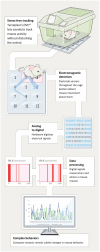Three Pillars of Automated Home-Cage Phenotyping of Mice: Novel Findings, Refinement, and Reproducibility Based on Literature and Experience
- PMID: 33192366
- PMCID: PMC7662686
- DOI: 10.3389/fnbeh.2020.575434
Three Pillars of Automated Home-Cage Phenotyping of Mice: Novel Findings, Refinement, and Reproducibility Based on Literature and Experience
Abstract
Animal models of neurodegenerative and neuropsychiatric disorders require extensive behavioral phenotyping. Currently, this presents several caveats and the most important are: (i) rodents are nocturnal animals, but mostly tested during the light period; (ii) the conventional behavioral experiments take into consideration only a snapshot of a rich behavioral repertoire; and (iii) environmental factors, as well as experimenter influence, are often underestimated. Consequently, serious concerns have been expressed regarding the reproducibility of research findings on the one hand, and appropriate welfare of the animals (based on the principle of 3Rs-reduce, refine and replace) on the other hand. To address these problems and improve behavioral phenotyping in general, several solutions have been proposed and developed. Undisturbed, 24/7 home-cage monitoring (HCM) is gaining increased attention and popularity as demonstrating the potential to substitute or complement the conventional phenotyping methods by providing valuable data for identifying the behavioral patterns that may have been missed otherwise. In this review, we will briefly describe the different technologies used for HCM systems. Thereafter, based on our experience, we will focus on two systems, IntelliCage (NewBehavior AG and TSE-systems) and Digital Ventilated Cage (DVC®, Tecniplast)-how they have been developed and applied during recent years. Additionally, we will touch upon the importance of the environmental/experimenter artifacts and propose alternative suggestions for performing phenotyping experiments based on the published evidence. We will discuss how the integration of telemetry systems for deriving certain physiological parameters can help to complement the description of the animal model to offer better translation to human studies. Ultimately, we will discuss how such HCM data can be statistically interpreted and analyzed.
Keywords: DVC; IntelliCage; behavior; mice; phenotyping; telemetry.
Copyright © 2020 Voikar and Gaburro.
Figures



Similar articles
-
IntelliCage: the development and perspectives of a mouse- and user-friendly automated behavioral test system.Front Behav Neurosci. 2024 Jan 3;17:1270538. doi: 10.3389/fnbeh.2023.1270538. eCollection 2023. Front Behav Neurosci. 2024. PMID: 38235003 Free PMC article. Review.
-
Accurate locomotor activity profiles of group-housed mice derived from home cage monitoring data.Front Neurosci. 2024 Sep 20;18:1456307. doi: 10.3389/fnins.2024.1456307. eCollection 2024. Front Neurosci. 2024. PMID: 39371613 Free PMC article.
-
A systematic review of the development and application of home cage monitoring in laboratory mice and rats.BMC Biol. 2023 Nov 13;21(1):256. doi: 10.1186/s12915-023-01751-7. BMC Biol. 2023. PMID: 37953247 Free PMC article.
-
Big data and its impact on the 3Rs: a home cage monitoring oriented review.Front Big Data. 2024 May 20;7:1390467. doi: 10.3389/fdata.2024.1390467. eCollection 2024. Front Big Data. 2024. PMID: 38831953 Free PMC article. Review.
-
Automated Home-Cage Monitoring During Acute Experimental Colitis in Mice.Front Neurosci. 2021 Oct 22;15:760606. doi: 10.3389/fnins.2021.760606. eCollection 2021. Front Neurosci. 2021. PMID: 34744621 Free PMC article.
Cited by
-
Excessive rest time during active phase is reliably detected in a mouse model of myotonic dystrophy type 1 using home cage monitoring.Front Behav Neurosci. 2023 Mar 2;17:1130055. doi: 10.3389/fnbeh.2023.1130055. eCollection 2023. Front Behav Neurosci. 2023. PMID: 36935893 Free PMC article.
-
Optimization of overhead enclosure monitoring in juvenile male Dunkin Hartley guinea pigs (Cavia porcellus).Lab Anim. 2023 Oct;57(5):552-564. doi: 10.1177/00236772231165810. Epub 2023 Apr 18. Lab Anim. 2023. PMID: 37070354 Free PMC article.
-
Identifying Cardiovascular Risk by Nonlinear Heart Rate Dynamics Analysis: Translational Biomarker from Mice to Humans.Brain Sci. 2025 Mar 14;15(3):306. doi: 10.3390/brainsci15030306. Brain Sci. 2025. PMID: 40149828 Free PMC article.
-
Automated home-cage for the evaluation of innate non-reflexive pain behaviors in a mouse model of inflammatory pain.Sci Rep. 2021 Jun 10;11(1):12240. doi: 10.1038/s41598-021-91444-4. Sci Rep. 2021. PMID: 34112846 Free PMC article.
-
Evidence-based comparative severity assessment in young and adult mice.PLoS One. 2023 Oct 20;18(10):e0285429. doi: 10.1371/journal.pone.0285429. eCollection 2023. PLoS One. 2023. PMID: 37862304 Free PMC article.
References
-
- Agorastos A., Heinig A., Stiedl O., Hager T., Sommer A., Muller J. C., et al. . (2019). Vagal effects of endocrine HPA axis challenges on resting autonomic activity assessed by heart rate variability measures in healthy humans. Psychoneuroendocrinology 102, 196–203. 10.1016/j.psyneuen.2018.12.017 - DOI - PubMed
-
- Anpilov S., Shemesh Y., Eren N., Harony-Nicolas H., Benjamin A., Dine J., et al. . (2020). Wireless optogenetic stimulation of oxytocin neurons in a semi-natural setup dynamically elevates both pro-social and agonistic behaviors. Neuron 107, 644.e7–655.e7.10.1016/j.neuron.2020.05.028 - DOI - PMC - PubMed
Publication types
LinkOut - more resources
Full Text Sources

